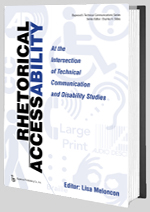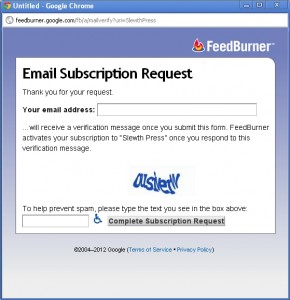Last week I highlighted Routledge’s online festival of free access to academic journals (to access the journals you have to register on their site, to begin 14 days of access at any point up until the 30th June 2012). My last post highlighted 19 papers with particular relevance to non-academics working in Education, Disability and Technology, based on a clutch of blog posts that I mustered for a similar festival last year. However, I also promised to highlight more recent research. So, for those of you hungry for the cutting edge – here’s my starter for 10.
Vasilis Galis (2011) “Enacting Disability: how can science and technology studies inform disability studies?”, Disability and Society, 26:1, p 825-838.
I blogged about this paper on the King’s Learning Institute’s Technology Enhanced Learning Blog for blogging against disablism day. This is a highly academic paper, and blog post, concerned with how disability studies and science and technology studies interact. However, I think many readers outside academia will still find something useful within it. Galis uses Actor Network Theory to identify how Disability might be concieved as an interaction, rather than an individual attribute, or external environment. Below, I reproduce my review from the KLI blog, which draws out particular implications for Technology Enhanced Learning. Your thoughts, as ever, are welcome. More posts on research from the last 12 months will follow in the next few days!
At the Sharp Edge of Technology Enhanced Learning: Science and Technology and Critical Disability Studies
…This post focuses on what learning technologists and disability scholars have to learn from one another and the importance of encouraging this traffic of ideas to combat digital disablism.
Specifically, I’d like to review a recent paper published in Disability and Society by Vasilis Galis (2011) “Enacting Disability: how can science and technology studies inform disability studies?”. At King’s, increasing interdisciplinary is resulting in new approaches to learning and technology across the College. However, when thinking about disability, much technology research and discussion focuses on accessibility, a fundamental part of user experience and human computer interaction rooted in computer science. In contrast, Disability Studies builds on a critical social science perspectives. Both engage activists, working to make digital experiences more inclusive. However, both accessibility and disability studies represent many diverse understandings of what disability is. When learning experiences are built on the results, for increasingly diverse student groups and interface devices, the picture complicates further.
Galis’ paper identifies theoretical frames from Science and Technology Studies that can assist in the ordering of disability and the representation of disability issues in different techno-scientific forums (or fora, depending which way you like your latin sliced) to clarify this space. His position has tangible applications for accessibility and Technology Enhanced Learning development.
To begin, Galis argues that:
Dominant conceptual models of disability have produced distinct dichotomies between the body, and semiotic and material entities (Galis, 2011: 826)
To set the scene, Galis reviews the medical model of disability, the social model of disability and the trajectory of postmodern approaches. He observes that many such lenses on disability rely on unhelpful distinctions (such as individual/social, illness/culture, body/socio-structural environment). Galis proposes a bridging intervention, highlighting the value of Actor Network Theory for promoting an interactional model of disability, in which disability (and impairment) are understood as being co-created between humans and “non-humans”.
Actor Network Theory
Within this model, “non-humans”, be they assistive technologies or other surfaces of technology (a ramp, browser, power supply, internet connection and so forth) and environmental factors, are considered ‘symmetrically’. Galis explains:
Actor Network Theory attempts to cancel the divide between human and non-human actors. In this way, ANT does not privilege impaired bodies (according to a medical model), or socio-material constructions (according to a social model). Instead ANT provides an analysis of a situation which may produce disability or ability (Galis, 2011, 830).
Actor Network Theory, he suggests, expands the vocabulary available to disability researchers and scholars. Importantly, Galis takes time to express criticism of this position, and carefully demarcate its limits.
From Galis’ argument, Actor Network Theory looks like a useful additional lens to those working at the chalk face of disability theory and leveraging the multiple-perspectives that are necessary for any mapping of the complex and contested arena of ‘disability’. However, I’m not sure that a relational model of disability, one that is gaining increasing traction with more critical Accessibility discourse (In my own work, most recently with Martyn Cooper et al. 2012) necessarily requires the vocabulary of Actor Network Theory. Moreover, this position strikes me a falling back into technicist discourses which render power relations invisible. Galis goes into this in some depth, drawing on Foucault and other critical theorists to forefront issues of ‘who is disabled, and who decides’. In this way, he applies a bricolage– recommending a use of ANT in the wild, (Callon, 2003) that produces knowledge through more recognisable emancipatory and participatory research practices, that engage disabled people, rather than foisting hierarchical academic power-relations upon them. This, Galis advises, requires the hard sciences to engage with ‘anti-science’, ‘concerned groups’ (Callon and Rabeharisoa, 2003) and ‘hybrid forums’ (Callon, 2003). Beneath the disciplinary jargon, this translates into a more precise, technical vocabulary for Sciences engaging with participatory disability research in the field.
Having undertaken participatory disability research in the wild, from within education (social science) and human factors (engineering), I recognise the strengths of a relational view of disability. By setting this view within an ANT vocabulary and an explicitly political framework, Galis overcomes the criticisms of localism and hegemony. However, I can’t help wondering whether, rather than informing disability studies with Science and Technology Studies, STS itself has instead been tested and developed by a critical engagement with disability? In any event – the benefits of critically considering disability, and its positioning within Science and Technical disciplines remains a rich seam that demands further investigation to ensure our design, deployment and social use of technology for learning does not “enact disability”.




